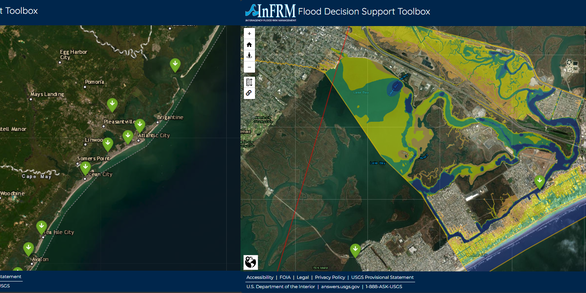Flooding in New Jersey
The USGS reports document New Jersey floods from 1896 to the present. Early spring and winter flooding in New Jersey tends to occur as a result of widespread, steady rain of moderate intensity that falls on frozen ground. Snow and ice melt may increase the chance of winter flooding. Summer flooding resulting from thunderstorms typically occurs in small streams and is of local extent. Late summer and fall flooding associated with frontal storms, tropical storms and hurricanes can be widespread, resulting from heavy intense rains across the entire state. New Jersey's major floods are those that are the most severe in terms of magnitude, areal extent, loss of life, and property damage.
Flooding can be a serious problem in many parts of New Jersey. Information on floods and analyses of flood data are needed to aid in the design of bridges, culverts, dams, highways, and buildings, and for the prudent management of flood-prone areas. Documentation of floods and a more thorough understanding of flood hydrology and hydraulics will result in more effective management of flood plains and design of structures.
The New Jersey Water Science Center (NJWSC) provides information on the magnitude and frequency of floods to agencies and individuals involved in flood-protection, planning, and design. The NJWSC also develops regional flood-frequency relations for streams in New Jersey to allow flood-frequency determinations at locations without stream gages and conducts local site studies using hydrologic and hydraulic analyses.
Found here are links to Reports Studies, and other useful links to New Jersey Flood Science.
NOTE: Flood peak discharges and estimates of flood recurrence intervals given in older USGS reports and web summaries may have been revised since their original publication. Check on-line peak flow for current discharges.
National Weatehr Service Flood Safety Information
New Jersey Water Science Center Webcams
Long-term Water Monitoring Networks in New Jersey
New Jersey: Coastal Flood Inundation Mapping
USGS Flood Information
New Jersey Coastal Surge, Wave, and Tide Hydrodynamics Network (SWaTH)
Floods: Recurrence intervals and 100-year floods Floods: Recurrence intervals and 100-year floods
New Jersey Flood Reports
Hurricanes and Storm-Tide Monitoring
Summary of recent flood and high-flow conditions (Water Watch)
WaterWatch - Floods NJ WaterWatch - Floods NJ
Below are publications associated with this project.
Moderate flood level scenarios—Synthetic storm-driven flood-inundation maps for coastal communities in 10 New Jersey counties Moderate flood level scenarios—Synthetic storm-driven flood-inundation maps for coastal communities in 10 New Jersey counties
Flood Magnitude and Frequency of the Delaware River in New Jersey, New York, and Pennsylvania Flood Magnitude and Frequency of the Delaware River in New Jersey, New York, and Pennsylvania
Somerset County Flood Information System Somerset County Flood Information System
New Jersey Tide Telemetry System New Jersey Tide Telemetry System
Real-time surface-water monitoring in New Jersey, 2003 Real-time surface-water monitoring in New Jersey, 2003
Passaic Flood Warning System Passaic Flood Warning System
New Jersey's Coastal Scenario Mapper and Flood Decision Tool New Jersey's Coastal Scenario Mapper and Flood Decision Tool
Flood Event Viewer Flood Event Viewer
Flood Inundation Mapper Flood Inundation Mapper
The USGS reports document New Jersey floods from 1896 to the present. Early spring and winter flooding in New Jersey tends to occur as a result of widespread, steady rain of moderate intensity that falls on frozen ground. Snow and ice melt may increase the chance of winter flooding. Summer flooding resulting from thunderstorms typically occurs in small streams and is of local extent. Late summer and fall flooding associated with frontal storms, tropical storms and hurricanes can be widespread, resulting from heavy intense rains across the entire state. New Jersey's major floods are those that are the most severe in terms of magnitude, areal extent, loss of life, and property damage.
Flooding can be a serious problem in many parts of New Jersey. Information on floods and analyses of flood data are needed to aid in the design of bridges, culverts, dams, highways, and buildings, and for the prudent management of flood-prone areas. Documentation of floods and a more thorough understanding of flood hydrology and hydraulics will result in more effective management of flood plains and design of structures.
The New Jersey Water Science Center (NJWSC) provides information on the magnitude and frequency of floods to agencies and individuals involved in flood-protection, planning, and design. The NJWSC also develops regional flood-frequency relations for streams in New Jersey to allow flood-frequency determinations at locations without stream gages and conducts local site studies using hydrologic and hydraulic analyses.
Found here are links to Reports Studies, and other useful links to New Jersey Flood Science.
NOTE: Flood peak discharges and estimates of flood recurrence intervals given in older USGS reports and web summaries may have been revised since their original publication. Check on-line peak flow for current discharges.
National Weatehr Service Flood Safety Information
New Jersey Water Science Center Webcams
Long-term Water Monitoring Networks in New Jersey
New Jersey: Coastal Flood Inundation Mapping
USGS Flood Information
New Jersey Coastal Surge, Wave, and Tide Hydrodynamics Network (SWaTH)
Floods: Recurrence intervals and 100-year floods Floods: Recurrence intervals and 100-year floods
New Jersey Flood Reports
Hurricanes and Storm-Tide Monitoring
Summary of recent flood and high-flow conditions (Water Watch)
WaterWatch - Floods NJ WaterWatch - Floods NJ
Below are publications associated with this project.












